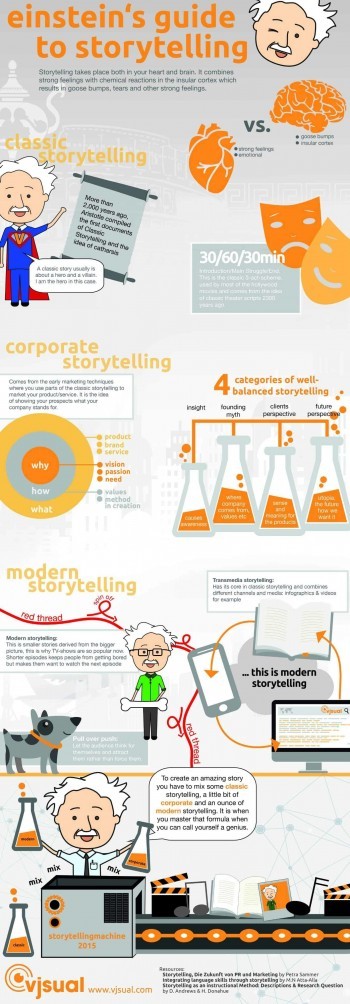
When it comes to successful online marketing, the most important thing is presenting content that tells a story. From emotional upswells that stir the heartstrings to incredible adventures in faraway lands, whatever your story is, you want to ensure that it’s a compelling and engaging one.
That being said, crafting compelling, engaging content for your business might seem easier said than done. Thankfully, history, science, and good old common sense have provided us with a variety of tools and tricks for creating amazing stories.
Engage the Brain
When you’re looking to create new content for your website, your first thought should be to the reaction you’re looking to evoke. Intrigue? Excitement? Curiosity? Whatever your emotion of choice, you should be considering the all of the ways in which you can engage your customer’s brain. Confused? Let us clarify.
There’s a particular region of the brain called the insular cortex. This part of the brain processes language, emotion, and the bodily reactions thereof. Thus, when you get goosebumps watching a scary movie or catch your breath reading a particularly suspenseful paragraph, the insular cortex is the reason why. Therefore, when crafting new content, you should be looking to engage this part of the brain to cause goosebumps and gasps of your own. Great storytelling will evoke these bodily reactions and have your customers excited to approach your business.
Lessons From History
Think this understanding of neurological processes is specific to the Internet Age? No way! Aristotle theorized that great storytelling could cause chemical reactions as early as 335 BCE. In his book Poetics, he even coined a term from this phenomenon: catharsis. What is catharsis exactly? Basically, catharsis occurs when a story causes an empathetic outpouring of emotion that cleanses and purifies the mind. Still not sure what that has to do with your business? Let’s look to a Fortune 500 company for an example.
In 2012, Procter and Gamble created a commercial series called “Thank You, Mom” for the Olympics. In a series of television and YouTube spots, the company told emotional stories of Moms using P&G products to help them do everything for their kids. The ads were poignant, compelling,and helped the company earn over $11.3 billion in profits that year. Their success is living proof of the power of catharsis.
Stories Need Structure
Convinced that you need a good story, but still not sure how to go about telling one? Let’s head back to Aristotle for some more on the ground tips. First of all, according to the expert, your story needs a protagonist – or, in layman’s terms, a hero. Your hero should complete some sort of quest, participate in a struggle, and bring said struggle to a resolution. Sound familiar? That’s because this story structure is still ubiquitous today. In fact, almost all blockbuster films follow this format, and as do most of the books that were on your compulsory reading list in school. It may seem like a cliche, but adhering to Aristotelian structure gives you a guideline in which you can craft your content, while also guaranteeing that your customers stay engaged and interested.
Give Them the Why, How, and What
Using lessons from history is important, but so is taking cues from modern business. Thus, we’ve taken inspiration from Simon Sinek – author of Start with Why – and his Golden Circle concept. In his TED Talk on the subject, Sinek explains that good corporate storytellers should focus on clarifying three sections of their business model – the why, the how, and the what. Confused? We’ll make it simple. The why of your business is its vision. Why are you passionate about what you do? What specific need is your product filling? The answer to these questions leads to the how. The how should focus on your values. This is where you can prove to your customers that you care about the wider community and understand your place in the bigger picture. Lastly, you should focus on the what. This is where you clarify the details of your product, and explain how your offerings are better than any others on the market.
Use Mixed Media
So now you know how to tell a story, but the question is, where do you tell it? Any small to medium-sized business should ensure that they’re taking advantage of transmedia storytelling options. What is transmedia storytelling? Transmedia storytelling is when different forms of media – from infographics to videos to photographs – are combined to create a modern marketing aesthetic. Utilizing transmedia storytelling doesn’t change your content — only how you present it.
Transmedia marketing ensures that you draw your customers in — in essence you pull them in instead of pushing them. What does that mean? Well, when it comes to your products, your clients are looking to connect the dots on their own. Rather than spoonfeeding them information, use all the tools at your disposal to create surprising and engaging content that enables them to reach their own conclusions. By empowering customers to reach a decision on their own, you place your trust in them, which leads to loyal, engaged consumers.
Put it All Together
As you can see, good storytelling comes from the imaginative application of valuable knowledge. From transmedia marketing to an engaging expression of your corporate story, a good lede can transform your business’ marketing campaign. So don’t be afraid to be creative with your storytelling! Crafting content that tells a story makes the difference between merely having a good product and having a business that is a success.
About the Author
vjsual – easily said, easily done
vjsual improves the way you communicate. We do so using video solutions. It can for example be in sales, customer care/service, explainer videos or tutorials
